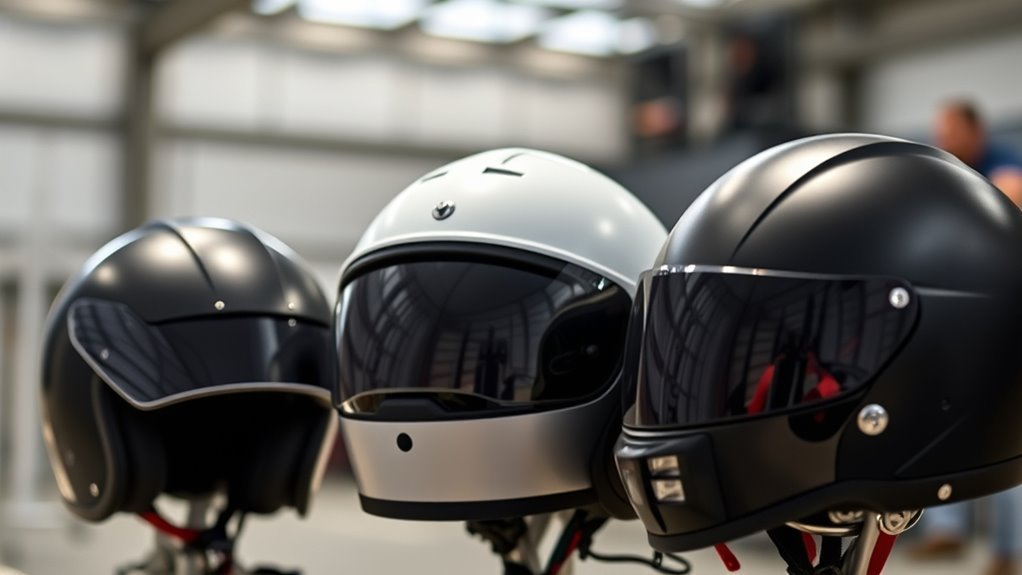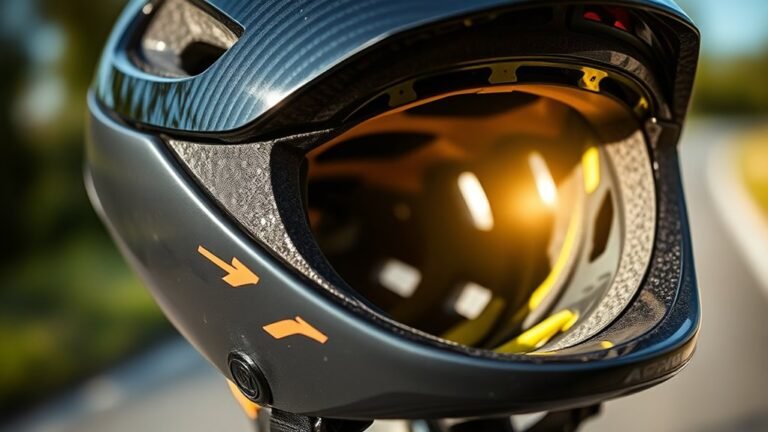How Helmet Shape Affects Safety
Helmet shape greatly affects safety by influencing how impact forces are absorbed and distributed. Aerodynamic designs, like those in cycling helmets, reduce drag, while rounded shapes in skateboarding helmets enhance flexibility and protection. The geometry plays an essential role; rounded shapes deflect impacts more effectively, minimizing injury risks. Materials also contribute to durability and energy absorption. Understanding the relationship between shape and safety is imperative. Discovering the nuances in design can further enhance your protection on various activities.
The Importance of Helmet Shape in Safety
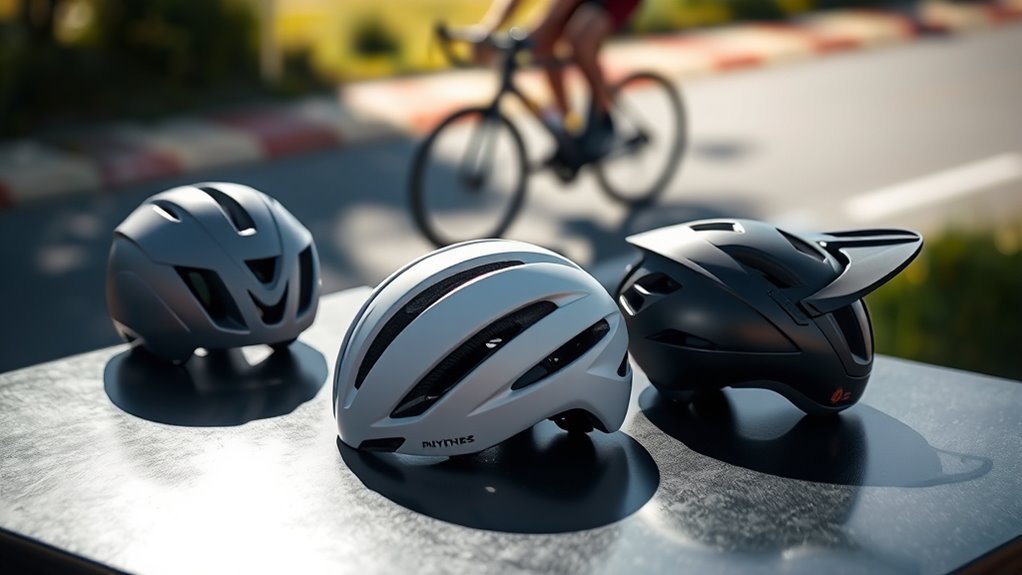
When considering the effectiveness of a helmet, it is vital to recognize that the shape plays a pivotal role in safety performance. The helmet design directly impacts how force is distributed during an impact, influencing the level of protection you receive. A well-structured helmet can enhance safety features, such as shock absorption and ventilation, while minimizing the risk of injury. Shapes that maximize aerodynamic efficiency not only improve comfort but also reduce drag, promoting freedom of movement. Understanding these design principles allows you to make informed choices, ensuring your helmet offers optimal protection without compromising your sense of adventure. Ultimately, selecting a helmet with a thoughtfully engineered shape is imperative for maintaining safety while enjoying the exhilaration of your activities.
Understanding Different Helmet Shapes
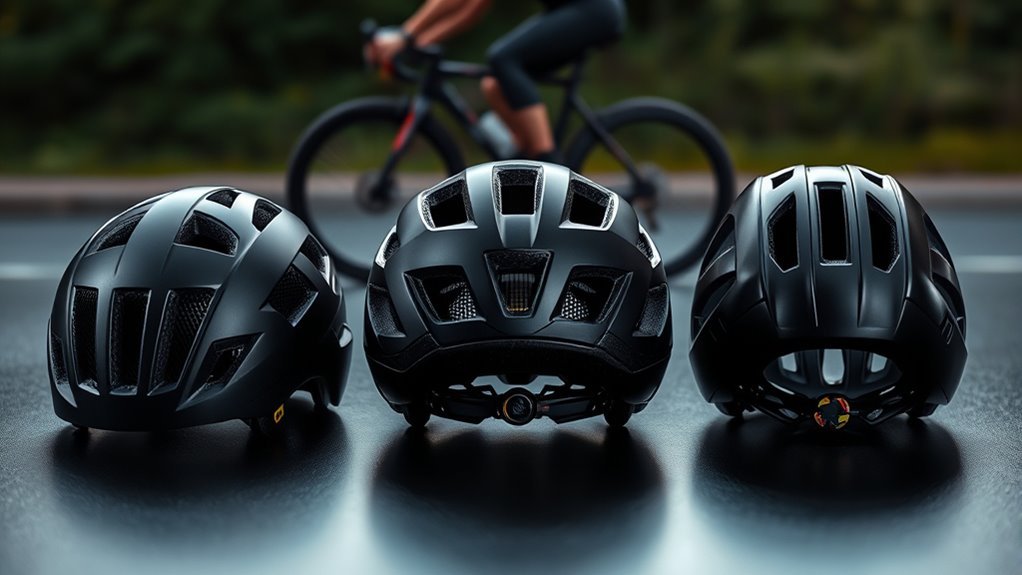
While various activities may require different helmet shapes, understanding these distinctions is essential for ensuring safety and performance. Helmet curvature effects can markedly influence how well a helmet absorbs impact and protects your head. The evolution of helmet design reflects a commitment to optimizing these shapes for specific activities.
| Activity | Helmet Shape | Key Features |
|---|---|---|
| Cycling | Aerodynamic | Streamlined, reduces drag |
| Skateboarding | Round | Enhanced protection, flexibility |
| Football | Rounded with visor | High-impact resistance |
| Mountain Biking | Extended rear | Better rear impact protection |
| Construction | Hard-shell | Durability, full head coverage |
Choosing the right helmet shape tailored to your activity can enhance safety and performance, promoting your freedom to engage confidently.
How Shape Influences Impact Absorption
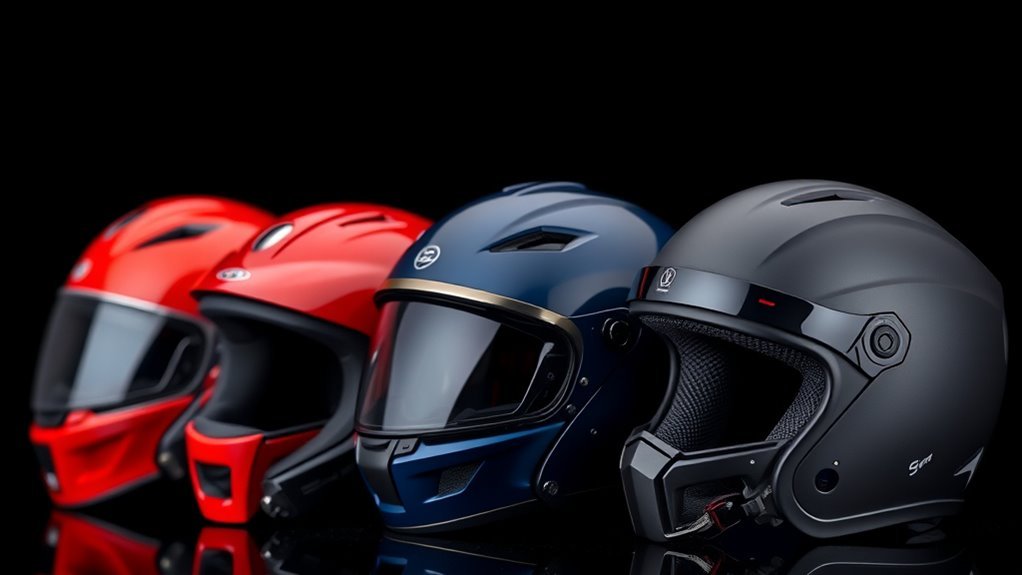
Understanding how helmet shape influences impact absorption is vital for enhancing safety across various activities. The geometric design of a helmet directly affects its ability to manage impact forces. When a helmet encounters different impact angles, its shape must be optimized to distribute forces evenly, minimizing the risk of injury. For instance, rounded shapes can deflect impacts more effectively, while angular designs may concentrate forces on specific points, increasing vulnerability. Shape optimization is essential in ensuring that helmets absorb energy effectively, reducing the force transmitted to the skull. By choosing a helmet with an appropriate shape, you’re not just prioritizing comfort; you’re also enhancing your safety by maximizing impact absorption capabilities, allowing for greater freedom of movement without compromising protection.
The Role of Materials in Helmet Design
In helmet design, the choice of materials directly impacts durability and the ability to absorb energy during an impact. You’ll need to reflect on how advancements in energy absorption technologies can enhance safety without greatly increasing weight. Balancing lightweight construction with protective capabilities is vital for ideal performance in helmets.
Material Durability and Impact
The choice of materials in helmet design greatly influences both durability and impact resistance, vital factors for ensuring user safety. When selecting materials, you need to take into account their performance under stress. For instance, polycarbonate and fiberglass are known for their excellent impact resistance, allowing helmets to withstand considerable forces without compromising structural integrity. Additionally, materials like expanded polystyrene (EPS) contribute to overall durability, enhancing the helmet’s lifespan. It’s essential to recognize that the right combination of materials can improve the helmet’s performance in real-world scenarios, providing you with the confidence to pursue your activities freely. Remember, the effectiveness of a helmet hinges not just on its shape, but markedly on the quality of materials used in its construction.
Energy Absorption Technologies
While many factors contribute to a helmet’s effectiveness, energy absorption technologies stand out as essential elements in enhancing user safety. These technologies utilize advanced materials that incorporate various energy absorption mechanisms, greatly mitigating impact forces. Here are key aspects to evaluate:
- EPS Foam: Provides excellent shock absorption while remaining lightweight.
- Multi-Density Foam: Offers varying levels of protection tailored to different impact scenarios.
- Viscoelastic Materials: These innovative cushioning systems adapt under pressure, distributing forces more evenly.
- Liquid or Gel Inserts: Enhance comfort and improve energy dispersion during impacts.
Lightweight vs. Protection Balance
Helmet design demands a careful balance between lightweight construction and robust protection. You want a helmet that feels almost weightless while still offering essential protective features. Lightweight materials, such as advanced polymers and carbon fiber, have revolutionized helmet design. These materials reduce overall weight, enhancing comfort and wearability, particularly during extended use. However, the challenge lies in ensuring that these lightweight options still meet safety standards. It’s vital to integrate effective protective features, such as multi-density foam liners and impact-resistant shells, which absorb energy during collisions. Ultimately, achieving this balance means you can enjoy the freedom of movement without compromising safety, allowing you to focus on your activities while feeling secure in your gear.
Aerodynamics and Its Effect on Performance
When evaluating performance in high-speed activities, understanding aerodynamics becomes essential. The shape of your helmet directly influences aerodynamic efficiency, which is vital for performance optimization. Here are four key factors to take into account:
- Drag Reduction: A streamlined shape minimizes air resistance, allowing you to maintain speed with less effort.
- Ventilation Design: Effective airflow can cool you down without compromising aerodynamics, enhancing comfort during high intensity.
- Weight Distribution: Proper weight balance can improve stability and reduce fatigue, enabling longer rides.
- Material Selection: Advanced materials can impact both aerodynamics and safety, ensuring you get the best of both worlds.
Testing Standards and Safety Ratings
When evaluating helmet safety, understanding testing methods is essential for interpreting safety ratings. Each standard examines specific impact scenarios that directly influence a helmet’s protective capabilities. By analyzing these methods, you can better appreciate how they correlate with safety ratings and overall helmet performance.
Testing Methods Overview
Testing methods for helmet safety are governed by a variety of standards and ratings that guarantee effectiveness in real-world scenarios. Understanding these testing protocols and evaluation criteria is vital for making informed choices. Here are key elements involved in helmet testing:
- Impact Testing: Measures the helmet’s ability to absorb shock during collisions.
- Penetration Testing: Assesses resistance against sharp objects that might breach the helmet.
- Retention System Testing: Evaluates how well the helmet stays in place during an impact.
- Field of Vision Assessment: Guarantees helmets don’t obstruct the wearer’s peripheral view.
Impact on Safety Ratings
Although various testing standards exist, their impact on safety ratings is vital for guaranteeing helmet performance in real-world scenarios. These standards evaluate helmets based on their ability to absorb impact and minimize injury risk. Shape variance plays an important role in this evaluation, as different designs can influence how force is distributed during impact. For instance, a streamlined shape may reduce drag but could compromise coverage. Conversely, a more rounded design might enhance protection but add weight. Understanding these trade-offs allows you to make informed decisions when selecting a helmet. Ultimately, adhering to established safety standards guarantees that the helmet you choose provides reliable protection, balancing comfort and safety for your freedom to ride confidently.
Choosing the Right Helmet Shape for Your Activity
How do you determine the most suitable helmet shape for your specific activity? Selecting the right helmet isn’t just about style; it’s essential for safety. Consider these factors for ideal helmet fit and activity suitability:
- Activity Type: Different sports require distinct shapes (e.g., road cycling vs. mountain biking).
- Ventilation Needs: Some activities demand more airflow, influencing design choices.
- Impact Zones: Assess the areas most likely to experience impacts based on your activity.
- Weight Considerations: Lighter helmets may enhance comfort for prolonged use.
Common Myths About Helmet Shapes
Many riders may believe that all helmet shapes offer the same level of protection, but this misconception can lead to serious safety risks. Myth debunking is essential in understanding that helmet shapes greatly influence how well they absorb impact forces. For instance, a rounder shape may reduce rotational forces better than a more elongated design. Shape misconceptions often arise from a lack of awareness about the physics of impact forces and how they interact with different helmet geometries. Not all helmets are created equal; the right shape can enhance your safety considerably. By educating yourself on these differences, you’re not just protecting your freedom to ride but also your very life. Prioritize knowledge to make informed choices for ideal safety.
Future Trends in Helmet Design and Safety
As technology advances, helmet design is evolving to enhance rider safety considerably. You’ll see several trends shaping the future of helmet technology:
- Smart Helmet Technology: Integration of sensors and Bluetooth for real-time communication and navigation.
- Innovative Materials: Use of lighter, more impact-resistant materials that improve comfort without sacrificing safety.
- Adaptive Ventilation: Systems that adjust airflow based on temperature and activity level, enhancing comfort during rides.
- Augmented Reality Features: Visors that display essential information, reducing the need to look away from the road.
These advancements not only aim to protect you but also enhance your riding experience, merging safety with the freedom you cherish.
Frequently Asked Questions
Can Helmet Shape Affect Comfort During Long Rides?
Yes, helmet shape can greatly affect comfort during long rides. Think of your helmet as a protective shell; its foam padding and ventilation design are essential for maintaining comfort. A well-shaped helmet distributes pressure evenly, reducing hot spots, while strategic ventilation allows airflow, preventing sweat build-up. The right shape not only enhances comfort but also empowers you to embrace the freedom of the open road without the distraction of discomfort.
How Do Different Shapes Impact Peripheral Vision?
Different helmet shapes can greatly impact your peripheral awareness and visibility range. A more streamlined design might limit side vision, while a rounder shape often enhances it, allowing for better awareness of your surroundings. This is essential for maintaining freedom during rides, as it enables you to spot potential hazards without turning your head excessively. Ultimately, choosing a helmet that balances safety and peripheral vision is key for an enjoyable riding experience.
Are Certain Shapes Better for Specific Sports?
Absolutely, certain shapes do excel in specific sports. Picture a cyclist slicing through the wind; their helmet’s aerodynamic benefits enhance speed. In contrast, a football player needs a design that absorbs impact while providing vision. Sport-specific designs optimize performance and safety, ensuring you get the most out of your gear. For instance, a streamlined helmet for racing minimizes drag, while a more robust shape for contact sports maximizes protection without sacrificing mobility.
Do Helmet Shapes Vary by Brand or Model?
Yes, helmet shapes do vary by brand and model. Each brand has its design philosophy, leading to brand comparisons that highlight differences in shape and fit. Model variations within a brand can also reflect specific purposes, such as racing or recreational use, affecting aerodynamics and comfort. Understanding these distinctions can help you choose the right helmet that aligns with your sport and preferences, ensuring you get the best protection without compromising on freedom of movement.
How Often Should I Replace My Helmet Based on Shape?
To guarantee safety, it’s crucial to replace your helmet every three to five years, regardless of its shape. The helmet lifespan hinges on factors like usage frequency and exposure to elements, as well as shape durability. If you notice any cracks, dents, or deformities, it’s time for a new one. Remember, a well-fitted helmet enhances your freedom while riding, so prioritize protection and don’t compromise on quality for style. Stay safe!
